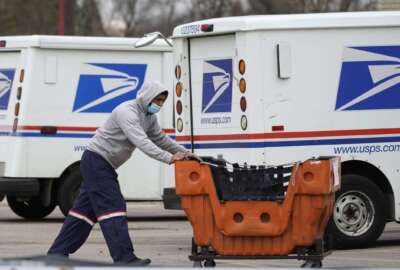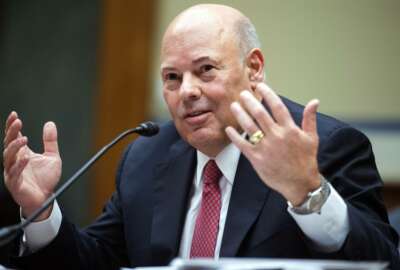USPS faces 3 lawsuits challenging its mostly gas-powered future vehicle fleet
The Postal Service is facing three separate lawsuits over its plans to purchase mostly gas-powered vehicles as part of its next-generation fleet.
The Postal Service is facing three separate lawsuits over its plans to purchase mostly gas-powered vehicles as part of its next-generation fleet.
California is leading 16 other states in a lawsuit to prevent USPS from taking any further action under its next-generation delivery vehicle contract, until it conducts a more in-depth environmental review.
Environmental groups and a major automotive union also filed lawsuits Thursday with the U.S. District Court of the Northern District of California and the Southern District of New York.
The lawsuits argue USPS set the estimated cost for electric vehicles unrealistically high as part of its environmental impact statement (EIS) but placed a low bar for the future price of gasoline.
The Government Accountability Office recently found said USPS used a 2020 gas price in its analysis that now is almost $2 per gallon less than the current national average.
“The Postal Service has a historic opportunity to invest in our planet and in our future. Instead, it is doubling down on outdated technologies that are bad for our environment and bad for our communities,” California Attorney General Rob Bonta said.
The Natural Resources Defense Council and the United Auto Workers (UAW) filed the lawsuit in New York, while EarthJustice is leading the lawsuit in California. Other plaintiffs in the latter case include the Sierra Club, Center for Biological Diversity and CleanAirNow KC.
The lawsuits claim USPS failed to take a “hard look” at the long-term environmental impact of a mostly gas-powered fleet.
“The crux of this case is that the Postal Service performed its NEPA analysis too late, and the analysis it did finally prepare was incomplete, misleading, and biased against cleaner vehicles,” the Earthjustice lawsuit states.
The lawsuits claim a new analysis under the National Environmental Policy Act could result in USPS replacing more of its fleet with electric vehicles.
The lawsuit led by Earthjustice asks the court to prevent USPS from “taking any action” until it drafts a new environmental impact study and a new cost estimate for electric vehicles.
USPS completed its environmental review of its next-generation delivery program in February and said it will move ahead with its “preferred alternative” plan to purchase up to 148,500 new internal-combustion vehicles over the next decade.
The agency expects these new vehicles will travel nearly 944,000 miles annually.
USPS expects electric vehicles will make up at least 10% of its next-generation fleet, but remains open to purchasing more electric vehicles if its finances improve, or if Congress authorizes funding to support its acquisition.
USPS last month spent nearly $3 billion on 50,000 next-generation vehicles as part of its initial order to the vendor Oshkosh Defense. More than 10,000 vehicles as part of that initial order are electric vehicles — more the double the number of EVs the agency expected to purchase.
Postmaster General Louis DeJoy said in a recent interview that said he’s not opposed to electric vehicles, but with an outdated fleet that’s “burning and breaking up every day,” he said USPS, more than anything, needs vehicles that work.
Its current fleet of Long-Life Vehicles lacks basic features such as airbags and anti-lock brakes.
“From a green perspective, we pay attention to this stuff, to the extent that our budget enables us. It’s not my primary mission. My primary mission is to deliver to 161 million addresses and cover my costs,” DeJoy said.
DeJoy said the agency has about two years until it has to make its next decision on how many additional electric vehicles it will purchase from Oshkosh Defense.
While USPS remains open to purchasing more electric vehicles, DeJoy said the agency also has other capital investments in the works, and may not have the funds to commit to a large electric vehicle fleet.
“We understand our operations better than anybody. We understand our cost of operations, how we would use things, but we have no skew on anything. I didn’t have mathematicians that were dying to get carbon burned higher. I had people engineering, we had routes, we studied it. We had assumptions at the time. At some point, you stop the assumptions. You have to make a decision,” DeJoy said.
USPS officials recently told the House Oversight and Reform Committee the agency was able to purchase more electric vehicles than previously expected because of the rising cost of gasoline, as well as long-term savings the agency is counting on, now that Congress has passed the first major piece of postal reform legislation in 15 years.
USPS spokeswoman Kim Frum said the agency’s contract with Oshkosh Defense allows for future increases for electric vehicles “should additional funding become available from internal or other sources,” and if the use case for electric vehicles continues to improve.
“The Postal Service is fully committed to the inclusion of electric vehicles as a significant part of our delivery fleet even though the investment will cost more than an internal combustion engine vehicle. That said, as we have stated repeatedly, we must make fiscally prudent decisions in the needed introduction of a new vehicle fleet,” Frum said.
USPS, in its final analysis, determined gas-powered vehicles in its next-generation fleet would produce about 311,739 metric tons of carbon dioxide a year.
The Environmental Protection Agency, which has challenged USPS for not making a stronger commitment to buy electric vehicles, estimates those same vehicles would emit 975,534 metric tons of carbon dioxide per year.
“This is more than a rounding error; it undercounts greenhouse gas emissions threefold,” Earthjustice’s lawsuit states.
The lawsuits also cite the White House Council on Environmental Quality’s opposition to the Postal Service’s mostly gas-powered fleet. In one recent letter to USPS, CEQ warned the agency that “federal courts may compel USPS to alter course.”
USPS currently has about 212,000 vehicles in its fleet, and more than 141,000 are LLVS.
Those LLVs average over $5,000 in annual maintenance costs, and the total average annual maintenance costs exceed for these vehicles $700 million.
Current LLVs have an average fuel efficiency of 8.2 miles per gallon and USPS estimates they consume over 97 million gallons of gasoline per year. The agency expects gas-powered vehicles in its next-generation fleet would get 8.6 miles per gallon with the air conditioning running. Without air conditioning running, they would get 14.7 miles per gallon.
USPS in its EIS estimates electric vehicles would have a range of 70 miles on a single charge, but would not be suited for an estimated 12,500 routes, about 5% of total routes nationwide. The average postal delivery route is just over 21 miles.
Plaintiffs in the Earthjustice-led lawsuit said electrifying the USPS fleet would reduce smog and pollution in nearly every neighborhood.
“Electrifying the postal fleet would dramatically reduce, or even eliminate, Postal Service gasoline costs in the coming decades — a surely welcome cost-saving given the significant and often unpredictable nature of fuel price fluctuations,” the lawsuit states. “But instead, the Postal Service doubled down on its reliance on fossil fuels for the foreseeable future, a decision that could cost the agency — and ultimately taxpayers — hundreds of millions of dollars.”
The USPS in its EIS said it will prioritize electric vehicles for longer routes in order to maximize fuel and maintenance savings, but doesn’t describe where those routes are located.
Copyright © 2025 Federal News Network. All rights reserved. This website is not intended for users located within the European Economic Area.
Jory Heckman is a reporter at Federal News Network covering U.S. Postal Service, IRS, big data and technology issues.
Follow @jheckmanWFED






